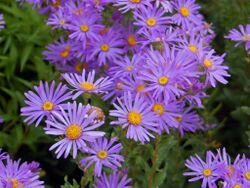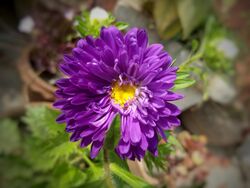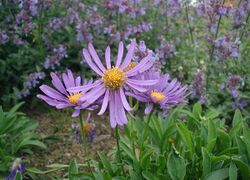Biology:Aster (genus)
| Aster | |
|---|---|

| |
| Aster amellus | |
| Scientific classification | |
| Kingdom: | Plantae |
| Clade: | Tracheophytes |
| Clade: | Angiosperms |
| Clade: | Eudicots |
| Clade: | Asterids |
| Order: | Asterales |
| Family: | Asteraceae |
| Subfamily: | Asteroideae |
| Tribe: | Astereae |
| Subtribe: | Asterinae |
| Genus: | Aster L., 1753 |
| Type species | |
| Aster amellus | |
| Synonyms[2] | |
|
List
| |
Aster is a genus of perennial flowering plants in the family Asteraceae. Its circumscription has been narrowed, and it now encompasses around 170 species, all but one of which are restricted to Eurasia; many species formerly in Aster are now in other genera of the tribe Astereae. Aster amellus is the type species of the genus and the family Asteraceae.[1]
The name Aster comes from the Ancient Greek word ἀστήρ (astḗr), meaning "star", referring to the shape of the flower head. Many species and a variety of hybrids and varieties are popular as garden plants because of their attractive and colourful flowers. 'Aster' species are used as food plants by the larvae of a number of Lepidoptera species—see list of Lepidoptera that feed on Aster. Asters can grow in all hardiness zones.
Circumscription
The genus Aster once contained nearly 600 species in Eurasia and North America, but after morphologic and molecular research on the genus during the 1990s, it was decided that the North American species are better treated in a series of other related genera. After this split there are roughly 180 species within the genus, all but one being confined to Eurasia.[3]
The New World species have now been reclassified in the genera Almutaster, Canadanthus, Doellingeria, Eucephalus, Eurybia, Ionactis, Oligoneuron, Oreostemma, Sericocarpus and Symphyotrichum, though all are treated within the same tribe, Astereae. The "China aster" is in the related genus Callistephus. Regardless of the taxonomic change, most are still widely referred to as "asters", or "Michaelmas daisies", because of their typical blooming period.
Species
Plants of the World Online accepts 185 species, as of November 2023.[2] The species formerly known as Aster tripolium (sea aster) is now Tripolium pannonicum. The species formerly known as Aster linosyris (goldilocks) is now Galatella linosyris. Many species and a variety of hybrids and varieties are popular as garden plants because of their beautiful, attractive and colourful flowers. Aster species are used as food plants by the larvae of a number of Lepidoptera species—see list of Lepidoptera that feed on Aster. Asters can grow in all hardiness zones.
Selected species:
- Aster ageratoides – rough-surface aster
- Aster alpinus – alpine aster
- Aster altaicus
- Aster amellus – European Michaelmas daisy, Italian aster
- Aster arenarius – beach-sand aster
- Aster bellidiastrum
- Aster fastigiatus – highly-branch aster
- Aster formosanus
- Aster glehnii – Ulleungdo aster
- Aster hayatae – Korean montane aster
- Aster hispidus[4]
- Aster iinumae – perennial false aster
- Aster incisus – incised-leaf aster
- Aster lautureanus – connected aster, mountain aster
- Aster maackii – Maack's aster
- Aster magnus – magnus aster
- Aster neoelegans
- Aster quitensis
- Aster spathulifolius – seashore spatulate aster
- Aster tataricus – Tatarian aster, Tatarinow's aster
- Aster tonglingensis[5]
- Aster tongolensis
- Aster yomena
Phytochemical Profile
- Flavonoids: These are commonly found in Asters and are known for their antioxidant properties. They may also impart color to the petals.
- Terpenoids: These could be responsible for the fragrance of some Aster flowers and are often studied for their potential medicinal properties. [6]
- Saponins: These phytochemicals create frothy solutions when agitated in water and have potential antimicrobial properties.
- Alkaloids: Though less common in Asters, if present, they could provide a range of bioactivities, including potential toxicity.
- Phenolic Compounds: These include tannins and other polyphenolic substances, which may contribute to the plant’s defense mechanisms. [7]
Hybrids and cultivars
Those marked agm have gained the Royal Horticultural Society's Award of Garden Merit.
- Aster × frikartii (A. amellus × A. thomsonii) Frikart's aster[8]
- 'Kylie' (A. novae-angliae 'Andenken an Alma Pötschke' × A. ericoides 'White Heather')[11]
- 'Ochtendgloren' agm[12] (A. pringlei hybrid)
- 'Photograph' agm[13]
In history
The Hungarian revolution of 31 October 1918, became known as the "Aster Revolution" due to protesters in Budapest wearing this flower.[14]
In culture
One of the few flowers left around Michaelmas in the British Isles is the Michaelmas daisy (another name for asters), hence the rhyme: "The Michaelmas daisies, among dead weeds, Bloom for St Michael's valorous deeds..."[15]
References
- ↑ 1.0 1.1 Elizabeth Pennissi (2001). "Linnaeus's last stand?". Science 291 (5512): 2304–2307. doi:10.1126/science.291.5512.2304. PMID 11269295.
- ↑ 2.0 2.1 "Aster L.". Board of Trustees of the Royal Botanic Gardens, Kew. 2023. https://powo.science.kew.org/taxon/urn:lsid:ipni.org:names:331068-2. Retrieved 19 November 2023.
- ↑ Luc Brouillet, Theodore M. Barkley & John L. Strother. "Asteraceae Martinov tribe Astereae Cassini, J. Phys. Chim. Hist. Nat. Arts. 88: 195. 1819". Flora of North America. p. 3. http://www.efloras.org/florataxon.aspx?flora_id=1&taxon_id=20538. in Flora of North America.
- ↑ "Aster hispidus". https://species.m.wikimedia.org/wiki/Aster_hispidus.
- ↑ "Convergent Origin of the narrowly lanceolate leaf in the Genus Aster—with Special Reference to An Unexpected Discovery of A New Aster Species from East China". Novataxa. 2019-01-27. http://novataxa.blogspot.com/2019/01/aster-tonglingensis.html.
- ↑ Sawant, Bhakti; Gupta, Vibha (2022-08-02). "Phytochemical Analysis and Extraction of Lutein using Column Chromatography from Tagetes and Aster plants". The Journal of Plant Science Research 38 (1): 327–331. doi:10.32381/jpsr.2022.38.01.35. ISSN 0970-2539. http://dx.doi.org/10.32381/jpsr.2022.38.01.35.
- ↑ Sharma, Dr Anubhav (2023-10-02). "Aster Plant: Description, Phytochemical, Classification & Benefits" (in en-US). https://thewitfire.in/2023/10/02/aster-plant-description-phytochemical-classification-benefits/.
- ↑ Floridata: Aster × frikartii
- ↑ "RHS Plant Selector - Aster × frikartii 'Mönch'". http://apps.rhs.org.uk/plantselector/plant?plantid=199.
- ↑ "RHS Plant Selector - A. × frikartii 'Wunder von Stäfa'". http://apps.rhs.org.uk/plantselector/plant?plantid=5443.
- ↑ Klein, Carol (2004-10-22). "Blazin' squad". Telegraph. https://www.telegraph.co.uk/gardening/3324244/Blazin-squad.html.
- ↑ "RHS Plant Selector - Aster 'Ochtendgloren'". http://apps.rhs.org.uk/plantselector/plant?plantid=2140.
- ↑ "RHS Plant Selector - Aster 'Photograph'". http://apps.rhs.org.uk/plantselector/plant?plantid=4504.
- ↑ Hajdu, Tibor (1990). "Revolution, Counterrevolution, Consolidation". in Peter F. Sugar. A History of Hungary ([New printing]. ed.). Bloomington: Indiana University Press. p. 297. ISBN 0253355788. https://archive.org/details/historyofhungary00pete.
- ↑ Rob Taylor (7 October 2010). "Michaelmas Traditions". Black Country Bugle. http://www.blackcountrybugle.co.uk/Michaelmas-Traditions/story-20144978-detail/story.html.
Wikidata ☰ Q517130 entry
 |



